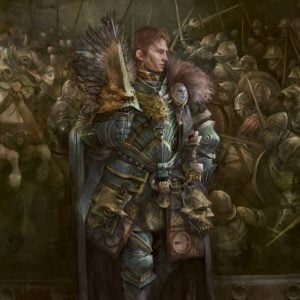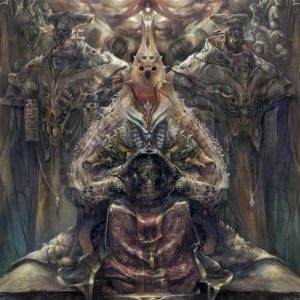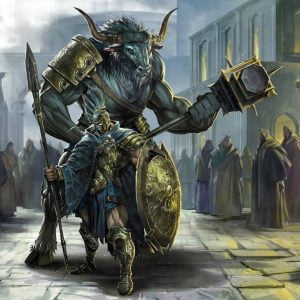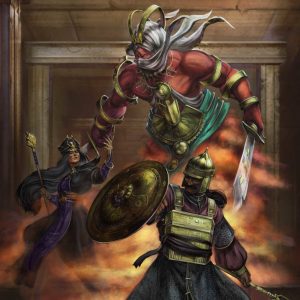
Trained and equipped to the highest standard, the Gilded Legion is one of the most feared forces in the Hundred Kingdoms. Their immaculate formations present rank upon rank of unwavering halberd tips facing their opponent. Their eponymous gilded armors hide the dour mien of trained veterans, drilled to an inch of their life and sanity by the most ruthless and effective instructors found in the Hundred Kingdoms.
The Gilded Legion could have had a reputation and a history at least as storied as that of the Steel Legion, as both trace their origins to the first professional forces Charles Armatellum established in his bid for Empire. Their position, however, as guardians of the Imperial Mint, their attendant duties as the protectors of the Imperial tax collectors and the controversial past of their legion, have all served to forever overshadow their accomplishments.
During the days of the Dissolution, the very first Chamberlain of the Empire, Gheorg Pfarrerson, realized he would need an armed force he could depend on to safeguard his charge from the predations of the nobility. The nobility, of course, had realized the same and the matter of the Imperial Legions would be the first to be discussed in the first Conclave. The outcome was clear from the very beginning and the Legions would be ordered to disband, however, the Chamberlain did manage to secure one token force for his command. The Gilded Legion was assigned to the Chamberlain, in his capacity as caretaker of the Mint. It was a mothballed military regiment, reduced by decades of garrison and guard duty to little more than glorified collection agents, reviled by the local populace for their graft and brutal methods. Its corrupted, prone to coin men presented no danger to the nobility’s deep pockets.
The denial of the Steel Legion to disband and the prolonged discussions of the first Conclave gave the Chamberlain the time he needed. Striking with the ruthlessness and methodical manner that would become the hallmark of his office, he ensured the survival of the Imperial dream by cleansing the one legion that was directly under his command. With the help of loyal men from the disbanded Legion of Smoke, he investigated and collected evidence on every last Gilded Guardsman. With incontrovertible evidence of their corruption, he issued an arrest warrant on every member of the Gilded Legion but the handful who had proven above corruption. These rare individuals he promoted to positions of command throughout the Legion. The rest he rounded up and issued an ultimatum: reform or die.
A few veterans, confident their long careers and shady connections would protect them, turned down the offer. They died the next day, their very executions serving as the first message to the nobility that the Chamberlain Office had teeth. Those who agreed to reform were subjected to the first Ordeal, a training regime developed by Aias Ekpatris, the exiled Polemarch of Tauria. Those who failed were condemned to heavy labor and were not seen again. Those who survived were awarded with a pardon and a new reward regime.
To limit the threat of gambling and dissolution, the legionnaire pay was moderate. In order to protect them from unwanted influences, while ensuring leverage over them, their families would live within the Gilded Legion compounds in Argem. And to ensure their loyalty, their honorable discharge dividend was increased to a princely sum, sufficient to provide for their family until death or to put two children through the Imperial Colleges of Argem. This sum was guaranteed for uncorrupted legionnaires. In the event of the legionnaire’s death, the family received the entirety of the sum as a stipend for the rest of their years. These financial motives ensured that there would be no shortage of applicant legionnaires lining up before the cavernous gates of the Imperial Mint in Argem, assuming, that is, they were ready to meet the strict requirements that developed over the centuries.
The recruitment standards of the Gilded Legion today are even stricter than those of the Steel Legion. Each candidate must be able to prove ten years of prior service in an armed and active unit. In addition, one must present two recommendation letters, at least one of which must be from a recognized imperial servant of the rank of Lictor and above, which provide assurances of the individual’s loyalty, skill and character. Once a prospective candidate’s credentials have been accepted, he must then endure the Ordeal, a fitness regime based on the Agoge practiced in the City States, one of the most ruthless training processes ever devised by man. While the hearts of the people would never be won despite the legion’s restructuring, what once was hatred and loathing, has turned into fearful contempt. In the end, Gilded Legionnaires care little. Sharing common living grounds, their families befriending each other, their children growing together, the Gilded Legion has become more than a choice, for many. It is a tradition and a way of life, often passing from one generation to the next, the bonds between its members as lasting and loyal as their dedication to their work.
Following these reforms, the Gilded Legion became a powerful tool in the hands of the Chamberlain, ensuring the sanctity and safety of the Imperial Mint, the most influential Imperial institution under his control. Loath to waste such a valuable resource on petty squabbles, the Gilded Legion cannot be hired out as common mercenaries and remains committed to its guard and garrison duties. Their presence on the battlefield means the Chamberlain himself has a vested interest in the outcome, a proposition almost as disheartening as facing these professional killers on the field.












